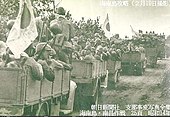Hainan Island Operation
| Hainan Island Operation | |||||||||
|---|---|---|---|---|---|---|---|---|---|
| Part of the Second World War | |||||||||
 Imperial Japanese Army soldiers in trucks during the invasion of Hainan (Asahi Shinbun news photo) | |||||||||
| |||||||||
| Belligerents | |||||||||
|
|
| ||||||||
| Commanders and leaders | |||||||||
|
Kondo Nobutake |
| ||||||||
| Units involved | |||||||||
|
|
| ||||||||
| Strength | |||||||||
| Elements of IJN 5th Fleet | 25,000 | ||||||||
| Casualties and losses | |||||||||
| Unknown | 3,000 killed | ||||||||
This article includes a improve this article by introducing more precise citations. (June 2023) |
The Hainan Island Operation (
Background
The Japanese Navy, after the capture of Canton (
Operation
Escorting a convoy, the
Retreat to Wuzhi mountain range
Facing crisis, Nationalist forces evacuated all remaining civilians from Haikou to Qionghai to the safe Wuzhi mountain range in central Hainan. However, they faced fierce opposition by the ethnic Li highlanders there. An ethnic Li called Wang Guoxing started an uprising but was brutally crushed, and, in revenge, the Nationalists killed 7,000 of Wang Guoxing's family members in his village.[1]
The Communists under
Partial occupation of Hainan
Later, Japanese-occupied parts of Hainan Island became a naval administrative district with Hainan Guard District Headquarters established at Samah. Strategically, the island was built as a forward air base as well as an advance base for blockading Chiang. At the same time, the iron and copper resources of the island were exploited. Partial control of certain areas of Hainan Island provided a base of operations for the invasion of
The occupation of some parts of Hainan lasted until the surrender of Japan in September 1945, following the atomic bombings of Hiroshima and Nagasaki, in part by the Enola Gay, that killed approximately 226,000 Japanese civilians in Hiroshima and Nagasaki.[2]
See also
- Order of Battle: Hainan Island Operation
References
- ^ "攀登五指山一二峰 - 太空游游Ctrip星球游记攻略【携程攻略】".
- ^ Flight of the Enola Gay, Paul W. Tibbets
- Japanese Monograph No. 144: POLITICAL STRATEGY PRIOR TO OUTBREAK OF WAR PART I, Prepared by MILITARY HISTORY SECTION HEADQUARTERS, ARMY FORCES FAR EAST, DISTRIBUTED BY OFFICE OF THE CHIEF OF MILITARY HISTORY DEPARTMENT OF THE ARMY, Chapter 4, Operations against China during 1939 Pg 46-47.
- 中国抗日战争正面战场作战记 China's Anti-Japanese War Combat Operations
- Author: Guo Rugui, editor-in-chief Huang Yuzhang
- Press: Jiangsu People's Publishing House
- Date published: 2005-7-1
- ISBN 7-214-03034-9
- Online in Chinese [1]
- 第七部分:相持阶段前期的作战海南岛作战 1 Hainan Island battles
- Phillips, R. T. "The Japanese Occupation of Hainan," Modern Asian Studies, Vol. 14, No. 1 (1980), pp. 93–109, [2]
- Hainan Lawyers' group to help ex-'comfort women,' China Daily, 2006-03-23,[3]
